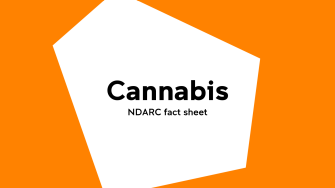15 May 2025
NDARC fact sheet:
Cannabis
Cannabis

Cannabis is derived from the cannabis plant (Cannabis sativa). It belongsto the depressant class of drugs and is the most widely used illicit drug in Australia.
The main active ingredient in cannabis is delta-9-tetrahydrocannabinol, commonly known as THC. This is the part of the plant responsible for most of the psychoactive effects or the ‘high’ experienced with cannabis use. There is a wide range of THC potency between cannabis products. Cannabis also contains the non-psychoactive cannabidiol (CBD).
Cannabis comes in different forms:
The effects of cannabis vary considerably from one person to another, and relevant factors include mood, body weight, previous experience with cannabis, and the specific form being used.
When cannabis is smoked, the active ingredient is absorbed directly from the lungs into the bloodstream, so the effect is almost immediate. Cannabis eaten in food takes longer to have an effect as it must be digested before it can enter the bloodstream. Oral absorption is highly variable, so the effects are often unpredictable.
Short-term effects include:
Long-term effects include:
A range of different chemicals that vary substantially in potency and effects are sold as synthetic cannabis. These products are often labelled as cannabis, but exhibit effects more typically associated with psychostimulants. Synthetic cannabinoids are classified as new/novel psychoactive substances.
Medicinal cannabis is typically prescribed to relieve the symptoms of a medical condition, such as epilepsy. These products are pharmaceutical-grade and tightly quality-controlled, with labelled levels of cannabinoids such as THC and CBD. They often come in the form of oral solution or capsules.
Prescriptions for these products are only available via a registered health practitioner through the TGA’s Special Access Scheme or Authorised Prescriber Scheme, and are assessed on a case-by-case basis.
There are no documented cases of death due to acute cannabis toxicity; however, high doses may produce a number of adverse effects including confusion, amnesia, delusions, hallucinations, anxiety, and agitation.
The effects of taking cannabis with other drugs, including over the counter or prescription medications, can be unpredictable.
Using cannabis with other drugs is more dangerous than using cannabis alone. Common combinations include cannabis and tobacco, and cannabis and alcohol.
The existence of cannabis dependence syndrome was a contested issue for the second half of the 20th century. It is now accepted as a real syndrome and formally included in the Diagnostic and Statistical Manual of Mental Illnesses (DSM-5), which is produced by the American Psychiatric Association.
There is considerable demand for treatment for cannabis withdrawal, which also suggests its presence.
Withdrawal symptoms peak in the first two to three days after quitting but may persist for weeks. These include:
While definitive causality is difficult to establish, there are many mental health risks associated with cannabis use. These include:
According to the Australian Institute of Health and Welfare’s National Drug Strategy Household Survey, cannabis continues to have the highest reported prevalence of lifetime and recent consumption in the general population, compared with other illicit drugs. In 2022-23, 11.6% of Australians aged 18 and over reported using cannabis in the past 12 months.
The Illicit Drug Reporting System (IDRS) is an Australian monitoring system run by the National Drug and Alcohol Research Centre (NDARC) at UNSW Sydney that identifies emerging trends of local and national concern in illicit drug markets.
The Ecstasy and Related Drugs Reporting System (EDRS) is an Australian monitoring system run by NDARC that identifies emerging trends of local and national interest in ecstasy and related drug use, markets and harms.
The Pocket Guide to Drugs and Health is a publication authored by experts from NDARC that provides information for health professionals on the impact of drug use.
The Australian Institute of Health and Welfare collects information on alcohol and tobacco consumption, and illicit drug use among the general population in Australia.
The Australian Bureau of Statistics is Australia’s national statistical agency, providing official statistics on a range of economic, social, population and environmental matters of importance to Australia.
Alcohol and Drug Foundation (2024). Cannabis. Retrieved from: adf.org.au/drug-facts/cannabis/
Australian Institute of Health and Welfare (2024). National Drug Strategy Household Survey 2022–2023: Cannabis in the NDSHS. AIHW, Australian Government. Retrieved from: aihw.gov.au/reports/illicit-use-of-drugs/cannabis-ndshs
Australian Institute of Health and Welfare (2024). Alcohol, tobacco & other drugs in Australia - Cannabis. AIHW, Australian Government. Retrieved from: aihw.gov.au/reports/alcohol/alcohol-tobacco-other-drugs-australia/contents/drug-types/cannabis#consumption
Department of Health and Aged Care: Office of Drug Control (2021). Frequently asked questions about medicinal cannabis. ODC, Australian Government. Retrieved from: odc.gov.au/medicinal-cannabis/grow-produce-or-manufacture-cannabis-australia/frequently-asked-questions-about-medicinal-cannabis
Darke, S., Lappin, J., & Farrell, M. (2024). The Clinician’s Guide to Illicit Drugs and Health (Revised Edition); London: Silverback Publishing.
Swift, W., Nielsen, S., Kaye, S., et al (2017). A Quick Guide to Drugs & Alcohol. Third Edition. Drug Info, State Library of New South Wales.
If you, or someone around you, is experiencing undesired or distressing psychological or physical symptoms from the intake of alcohol or other drugs, please seek immediate medical attention.
If you need urgent help from ambulance services, call Triple Zero (000). If a person has been mixing drugs with alcohol or other drugs, tell the paramedic exactly what has been taken.
For free and confidential advice about alcohol and other drugs, call the National Alcohol and Other Drug Hotline on 1800 250 015. The hotline will automatically direct you to the Alcohol and Drug Information Service in your state or territory.
15 May 2025
Fact Sheets
NDARC
Download this resource